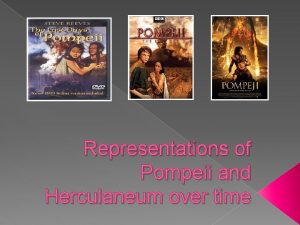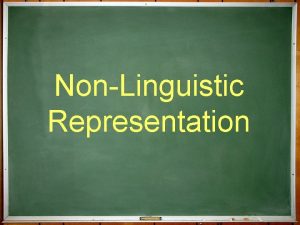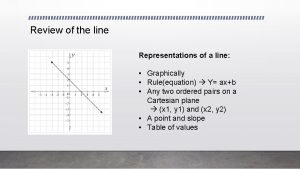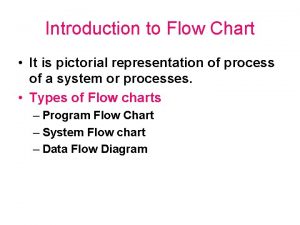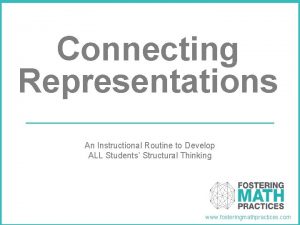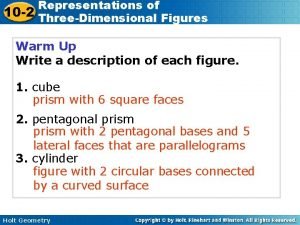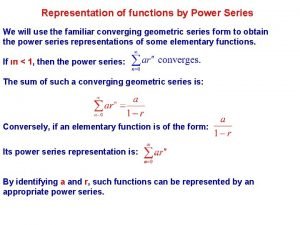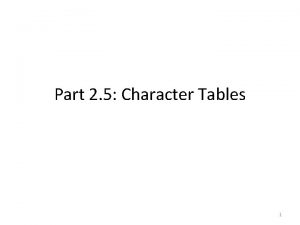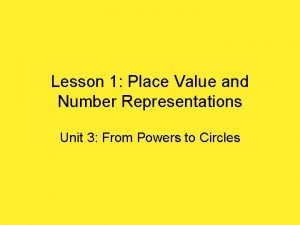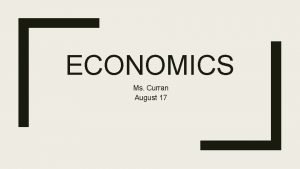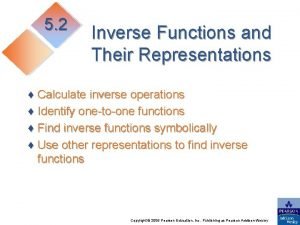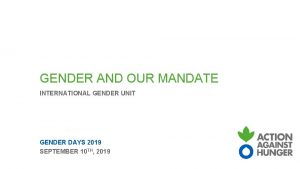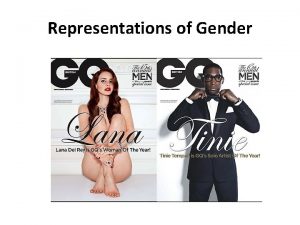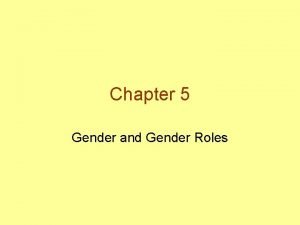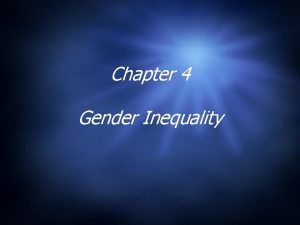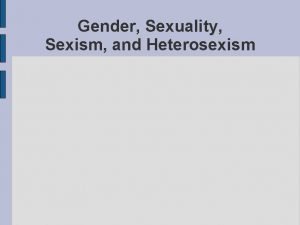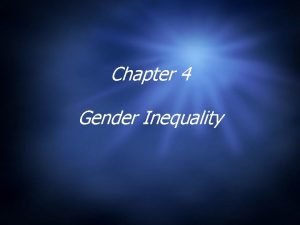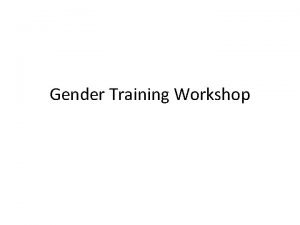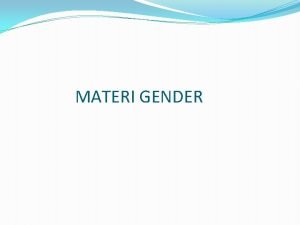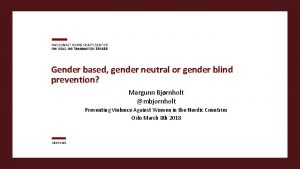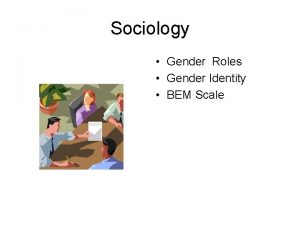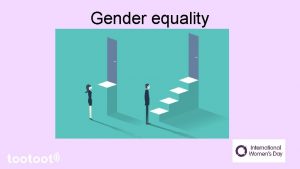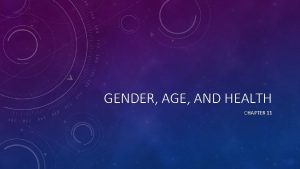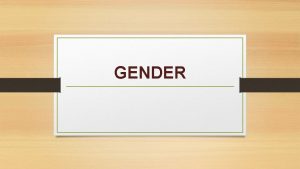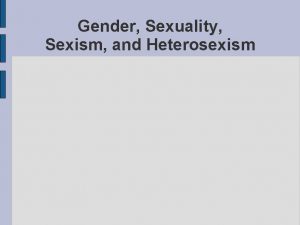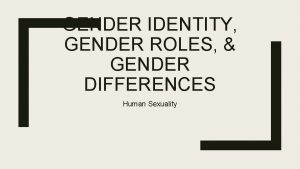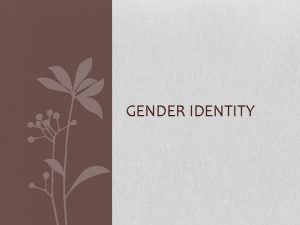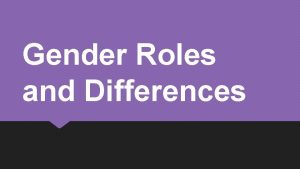Unit 1 REPRESENTATIONS Introduction to gender representations Learning





































- Slides: 37

Unit 1: REPRESENTATIONS Introduction to gender representations

Learning Intention To begin to analyse how gender has been represented throughout history.

Representation Of Gender & Stereotypes

How many gender stereotypes can you brainstorm?

Representation of Women Read p. 21 -23 You read this for homework. What were the key points you picked up from this reading?

Gender representations and reality…. The Media is often criticized for representing unrealistic ideals of women…let’s view these clips… Body Evolution http: //www. youtube. com/watch? v=17 j 5 Qz. F 3 kq. E Dove Evolution TVC http: //www. youtube. com/watch? v=hiby. AJOSW 8 U What do you believe is the effect of these representations? Are they right or wrong? Why do they exist?

What is gender? "Sex" refers to the biological and physiological characteristics that define men and women. "Gender" refers to the socially constructed roles, behaviours, activities, and attributes that a given society considers appropriate for men and women. . and transgender should be part of this too.

• Consider birthday cards and girls/boys magazines. • What do these say about what it means to be a boy/girl? What do boys like and what do girls like?

• Do you think this changes in men’s/women’s magazines? • Spend 5 minutes searching online for images of ‘men’s magazines’ and ‘women’s magazines’. • What do they feature? • What does this suggest is important about men/women? • What do you think about this?

Masculinity and femininity Gender and representation of gender is tied up with ideas of masculinity and femininity. . . Are the following ideas about the representation of men and women reinforced by what you found in the magazines?

Representation of Men 'Masculinity' is a concept that is made up of more rigid stereotypes than femininity. Representations of men across all media tend to focus on the following: • Strength - physical and intellectual • Power • Sexual attractiveness (which may be based on the above) • Physique • Independence (of thought, action, finances)

Representation of Men • Male characters are often represented as isolated, as not needing to rely on others (the lone hero). If they submit to being part of a family, it is often part of the resolution of a narrative, rather than an integral factor in the initial balance. • It is interesting to note that the male physique is becoming more important a part of representations of masculinity.

Representation of Women Representations of women across all media tend to highlight the following: • beauty (within narrow conventions) • size/physique (again, within narrow conventions) • sexuality (as expressed by the above) • emotional (as opposed to intellectual) dealings • relationships (as opposed to independence/ freedom)

Representation of Women • Women are often represented as being part of a context (family, friends, colleagues) and working/thinking as part of a team. In drama, they tend to take the role of helper (Propp) or object, passive rather than active. • Often their passivity extends to victimhood. Men are still represented as TV drama characters up to 3 times more frequently than women, and tend to be the predominant focus of news stories.

Media representations of gender • Consider the views put forward in these videos. Do you agree? • http: //www. mediaed. org/cgi-bin/commerce. cgi? preadd=action&key=234 • http: //www. youtube. com/watch? v=NX 3 w 4 leth 9 I

Masculinity and femininity • How does society treat people who do not conform to gender norms (i. e. men who are feminine and women who are masculine)? • So what is our society's dominant ideology about gender (i. e. what gender attributes and behaviours are valued most in our society on the whole)?

Media representations of gender • Music video to consider: https: //www. youtube. com/watch? v=i 0 v. Fid 2 t. Kb. I • What does this music video suggest it means to have a good time as a man? As a woman? • How are the male characters represented? • How are the female characters represented? • Do these representations draw on any cultural norms about gender?

Stereotypes • A stereotype is an oversimplified, clichéd image, repeated so many times that it seems to have established a pattern. It is a highly judgemental type of representation. • Stereotyping is an important concept in terms of representation.

Stereotypes • Stereotypes change with time • If you look at TV drama from the past it is strange to see how inappropriately some demographics (particularly minorities such as homosexuals or ethnic groups) were depicted or represented. • Love Thy Neighbour clip

Stereotype production is based on… • Simplification • Exaggeration or distortion • Generalisation • Presentation of cultural attributes as being 'natural'. Does it matter?

The Countertype • A positive stereotype. • Focuses on positive elements of a group traditionally represented as bad. • Still an oversimplification of the enormous diversity featured with the group.

Stereotype or countertype?

Stereotype or countertype? 1. What is denoted? (Describe what the image contains using the technical elements, e. g. details of mise en scene and camerawork. ) 2. What is connoted? (Explain how the image might be interpreted, e. g. what do the denotations suggest about the characters? ) 3. What is the significance of the representations? (Does the image present a stereotype or countertype? Why? – consider masculinity/femininity. Is this a common representation? Is it a positive or negative representation? )

Stereotype or countertype?

Stereotype or countertype?

Stereotype or countertype?

Stereotype or countertype?

Homework Find examples of TV Drama characters who you think, 1. reinforce gender stereotypes 2. challenge gender stereotypes Create a collage of characters for each with annotations explaining your choice. Post this on a new AS Media Exam journal. Email work to teacher if you have any problems posting on your journal.

Representations of gender are reinforced from a young age http: //www. youtube. com/watch? v=w 2 b. Yin. Z 6 RX 0 Watch from start to 2: 10 • • How are each of the ads different? How are producers trying to target the different genders? What are girls being stereotyped as? What are boys being stereotyped as?

How has representations of women changed from 1930 s to today? Has it changed at all?

Media: New ways and meaning : Representation of gender handout 1. According to this article how are women represented in: a) 1930 s-1940 s b) 1950 s-1960 s c) 1970 s-1980 s d) 1990 s-2000 s 2. Choose two of the above time periods and note as many female characters from TV or film (that was produced at the time). Do these characters fit with a) the context of values of the time period b) a stereotype or mixture of stereotypes found on page 43 Example: Lucille Ball from ‘I Love Lucy’ a) Yes, she is ‘tamed by marriage’ and controlled by her husband as he often has to help her out of trouble and then consequently reprimands her. b) She fits in the ‘dumb blonde’ stereotype as her character is often exaggerated to the point where she ends up in predicaments because of her inability to stay within the realms of the domestic household. 3. Choose one of the female stereotypes found on page 43 and create a character that fits that stereotype. Draw an image using as many codes and conventions to create your representation.

Representations within the context of Media history

Throughout history brainstorm as many examples of expectations that society place on both; a) Women b) Men For example: Women should be a domestic goddess. Women should dress to please men. Men should be bread winners. Men should be SNAG.

Gender Representation Timeline See previous handout (New Ways) Women 1920 1930 1940 1950 1960 1970 1980 1990 2000 Men 1920 Place your previous brainstormed ideas onto a timeline.

What traits does society want men and women to have? How does the media represent men and women? What happens when the media’s representation is different to what society demands of gender stereotypes?

SOCIALLY ACCEPTED FEMINE TRAITS SOCIALLY ACCEPTED MASUCLINE TRAITS Beautiful Sumissive Bread winner athletic

HOMEWORK • Complete Homework reading and questions on the weebly under the heading; • AUDIENCE
 Strategic gender needs and practical gender needs
Strategic gender needs and practical gender needs Gcse media studies nea 2021
Gcse media studies nea 2021 Cuadro comparativo e-learning y b-learning
Cuadro comparativo e-learning y b-learning Vpey
Vpey Unit 10, unit 10 review tests, unit 10 general test
Unit 10, unit 10 review tests, unit 10 general test On single image scale-up using sparse-representations
On single image scale-up using sparse-representations Representations of pompeii and herculaneum over time
Representations of pompeii and herculaneum over time What are nonlinguistic representations
What are nonlinguistic representations Example of time pattern organizer
Example of time pattern organizer Representations of a line
Representations of a line Cultural representations and signifying practices
Cultural representations and signifying practices Efficient estimation of word representations invector space
Efficient estimation of word representations invector space Distributed representations of words
Distributed representations of words Isa 580 written representations summary
Isa 580 written representations summary Floor plan maths literacy grade 12
Floor plan maths literacy grade 12 Types of maps in maths lit grade 11
Types of maps in maths lit grade 11 Maps, plans and other representations of the physical world
Maps, plans and other representations of the physical world Flowchart pictorial representation
Flowchart pictorial representation Efficient estimation of word representations
Efficient estimation of word representations Connecting representations
Connecting representations Multiple representations
Multiple representations Multiple representations
Multiple representations Representations of three dimensional figures
Representations of three dimensional figures Representations of functions as power series
Representations of functions as power series Character table for d infinity h
Character table for d infinity h Elevation map grade 12 maths lit
Elevation map grade 12 maths lit Place value representations
Place value representations Simplified representations of complex economic activities
Simplified representations of complex economic activities Multiple representations of polar coordinates
Multiple representations of polar coordinates Functions and their representations
Functions and their representations Supervised learning dan unsupervised learning
Supervised learning dan unsupervised learning Concept learning task in machine learning
Concept learning task in machine learning Analytical learning in machine learning
Analytical learning in machine learning Non associative learning example
Non associative learning example Eager learning examples
Eager learning examples What is conceptual learning
What is conceptual learning Inductive analytical approach to learning
Inductive analytical approach to learning Apprenticeship learning via inverse reinforcement learning
Apprenticeship learning via inverse reinforcement learning






